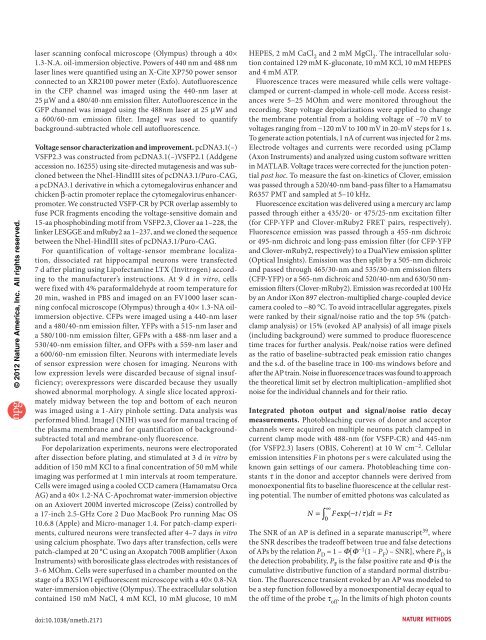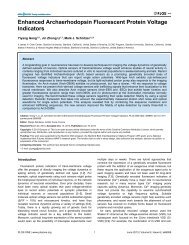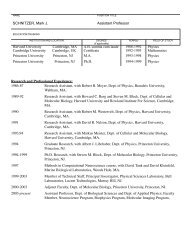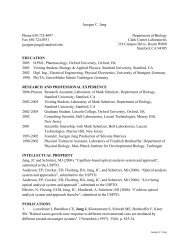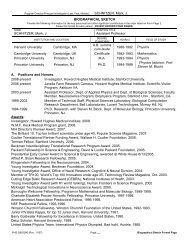improving Fret dynamic range with bright green and red fluorescent ...
improving Fret dynamic range with bright green and red fluorescent ...
improving Fret dynamic range with bright green and red fluorescent ...
- No tags were found...
Create successful ePaper yourself
Turn your PDF publications into a flip-book with our unique Google optimized e-Paper software.
© 2012 Nature America, Inc. All rights reserved.laser scanning confocal microscope (Olympus) through a 40×1.3-N.A. oil-immersion objective. Powers of 440 nm <strong>and</strong> 488 nmlaser lines were quantified using an X-Cite XP750 power sensorconnected to an XR2100 power meter (Exfo). Autofluorescencein the CFP channel was imaged using the 440-nm laser at25 µW <strong>and</strong> a 480/40-nm emission filter. Autofluorescence in theGFP channel was imaged using the 488nm laser at 25 µW <strong>and</strong>a 600/60-nm emission filter. ImageJ was used to quantifybackground-subtracted whole cell autofluorescence.Voltage sensor characterization <strong>and</strong> improvement. pcDNA3.1(–)VSFP2.3 was constructed from pcDNA3.1(–)VSFP2.1 (Addgeneaccession no. 16255) using site-directed mutagenesis <strong>and</strong> was subclonedbetween the NheI-HindIII sites of pcDNA3.1/Puro-CAG,a pcDNA3.1 derivative in which a cytomegalovirus enhancer <strong>and</strong>chicken β-actin promoter replace the cytomegalovirus enhancerpromoter.We constructed VSFP-CR by PCR overlap assembly tofuse PCR fragments encoding the voltage-sensitive domain <strong>and</strong>15-aa phosphobinding motif from VSFP2.3, Clover aa 1–228, thelinker LESGGE <strong>and</strong> mRuby2 aa 1–237, <strong>and</strong> we cloned the sequencebetween the NheI-HindIII sites of pcDNA3.1/Puro-CAG.For quantification of voltage-sensor membrane localization,dissociated rat hippocampal neurons were transfected7 d after plating using Lipofectamine LTX (Invitrogen) accordingto the manufacturer’s instructions. At 9 d in vitro, cellswere fixed <strong>with</strong> 4% paraformaldehyde at room temperature for20 min, washed in PBS <strong>and</strong> imaged on an FV1000 laser scanningconfocal microscope (Olympus) through a 40× 1.3-NA oilimmersionobjective. CFPs were imaged using a 440-nm laser<strong>and</strong> a 480/40-nm emission filter, YFPs <strong>with</strong> a 515-nm laser <strong>and</strong>a 580/100-nm emission filter, GFPs <strong>with</strong> a 488-nm laser <strong>and</strong> a530/40-nm emission filter, <strong>and</strong> OFPs <strong>with</strong> a 559-nm laser <strong>and</strong>a 600/60-nm emission filter. Neurons <strong>with</strong> intermediate levelsof sensor expression were chosen for imaging. Neurons <strong>with</strong>low expression levels were discarded because of signal insufficiency;overexpressors were discarded because they usuallyshowed abnormal morphology. A single slice located approximatelymidway between the top <strong>and</strong> bottom of each neuronwas imaged using a 1-Airy pinhole setting. Data analysis wasperformed blind. ImageJ (NIH) was used for manual tracing ofthe plasma membrane <strong>and</strong> for quantification of backgroundsubtractedtotal <strong>and</strong> membrane-only fluorescence.For depolarization experiments, neurons were electroporatedafter dissection before plating, <strong>and</strong> stimulated at 3 d in vitro byaddition of 150 mM KCl to a final concentration of 50 mM whileimaging was performed at 1 min intervals at room temperature.Cells were imaged using a cooled CCD camera (Hamamatsu OrcaAG) <strong>and</strong> a 40× 1.2-NA C-Apochromat water-immersion objectiveon an Axiovert 200M inverted microscope (Zeiss) controlled bya 17-inch 2.5-GHz Core 2 Duo MacBook Pro running Mac OS10.6.8 (Apple) <strong>and</strong> Micro-manager 1.4. For patch-clamp experiments,cultu<strong>red</strong> neurons were transfected after 4–7 days in vitrousing calcium phosphate. Two days after transfection, cells werepatch-clamped at 20 °C using an Axopatch 700B amplifier (AxonInstruments) <strong>with</strong> borosilicate glass electrodes <strong>with</strong> resistances of3–6 MOhm. Cells were superfused in a chamber mounted on thestage of a BX51WI epi<strong>fluorescent</strong> microscope <strong>with</strong> a 40× 0.8-NAwater-immersion objective (Olympus). The extracellular solutioncontained 150 mM NaCl, 4 mM KCl, 10 mM glucose, 10 mMHEPES, 2 mM CaCl 2<strong>and</strong> 2 mM MgCl 2. The intracellular solutioncontained 129 mM K-gluconate, 10 mM KCl, 10 mM HEPES<strong>and</strong> 4 mM ATP.Fluorescence traces were measu<strong>red</strong> while cells were voltageclampedor current-clamped in whole-cell mode. Access resistanceswere 5–25 MOhm <strong>and</strong> were monito<strong>red</strong> throughout therecording. Step voltage depolarizations were applied to changethe membrane potential from a holding voltage of −70 mV tovoltages ranging from −120 mV to 100 mV in 20-mV steps for 1 s.To generate action potentials, 1 nA of current was injected for 2 ms.Electrode voltages <strong>and</strong> currents were recorded using pClamp(Axon Instruments) <strong>and</strong> analyzed using custom software writtenin MATLAB. Voltage traces were corrected for the junction potentialpost hoc. To measure the fast on-kinetics of Clover, emissionwas passed through a 520/40-nm b<strong>and</strong>-pass filter to a HamamatsuR6357 PMT <strong>and</strong> sampled at 5–10 kHz.Fluorescence excitation was delive<strong>red</strong> using a mercury arc lamppassed through either a 435/20- or 475/25-nm excitation filter(for CFP-YFP <strong>and</strong> Clover-mRuby2 FRET pairs, respectively).Fluorescence emission was passed through a 455-nm dichroicor 495-nm dichroic <strong>and</strong> long-pass emission filter (for CFP-YFP<strong>and</strong> Clover-mRuby2, respectively) to a DualView emission splitter(Optical Insights). Emission was then split by a 505-nm dichroic<strong>and</strong> passed through 465/30-nm <strong>and</strong> 535/30-nm emission filters(CFP-YFP) or a 565-nm dichroic <strong>and</strong> 520/40-nm <strong>and</strong> 630/50 nmemissionfilters (Clover-mRuby2). Emission was recorded at 100 Hzby an Andor iXon 897 electron-multiplied charge-coupled devicecamera cooled to −80 °C. To avoid intracellular aggregates, pixelswere ranked by their signal/noise ratio <strong>and</strong> the top 5% (patchclampanalysis) or 15% (evoked AP analysis) of all image pixels(including background) were summed to produce fluorescencetime traces for further analysis. Peak/noise ratios were definedas the ratio of baseline-subtracted peak emission ratio changes<strong>and</strong> the s.d. of the baseline trace in 100-ms windows before <strong>and</strong>after the AP train. Noise in fluorescence traces was found to approachthe theoretical limit set by electron multiplication–amplified shotnoise for the individual channels <strong>and</strong> for their ratio.Integrated photon output <strong>and</strong> signal/noise ratio decaymeasurements. Photobleaching curves of donor <strong>and</strong> acceptorchannels were acqui<strong>red</strong> on multiple neurons patch clamped incurrent clamp mode <strong>with</strong> 488-nm (for VSFP-CR) <strong>and</strong> 445-nm(for VSFP2.3) lasers (OBIS, Coherent) at 10 W cm −2 . Cellularemission intensities F in photons per s were calculated using theknown gain settings of our camera. Photobleaching time constantsτ in the donor <strong>and</strong> acceptor channels were derived frommonoexponential fits to baseline fluorescence at the cellular restingpotential. The number of emitted photons was calculated as∞N = ∫ F exp( − t / t)dt = Ft0The SNR of an AP is defined in a separate manuscript 39 , wherethe SNR describes the tradeoff between true <strong>and</strong> false detectionsof APs by the relation P D= 1 – Φ[Φ −1 (1 – P F) – SNR], where P Disthe detection probability, P Fis the false positive rate <strong>and</strong> Φ is thecumulative distributive function of a st<strong>and</strong>ard normal distribution.The fluorescence transient evoked by an AP was modeled tobe a step function followed by a monoexponential decay equal tothe off time of the probe τ off. In the limits of high photon countsdoi:10.1038/nmeth.2171nature methods


